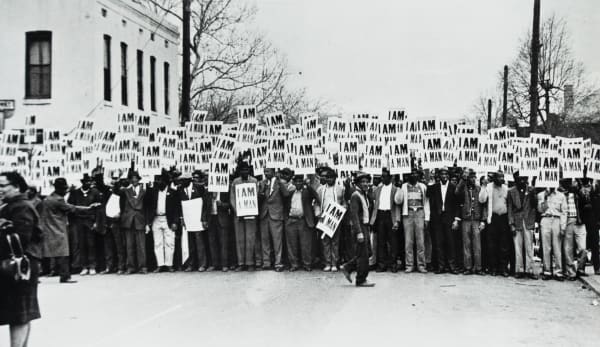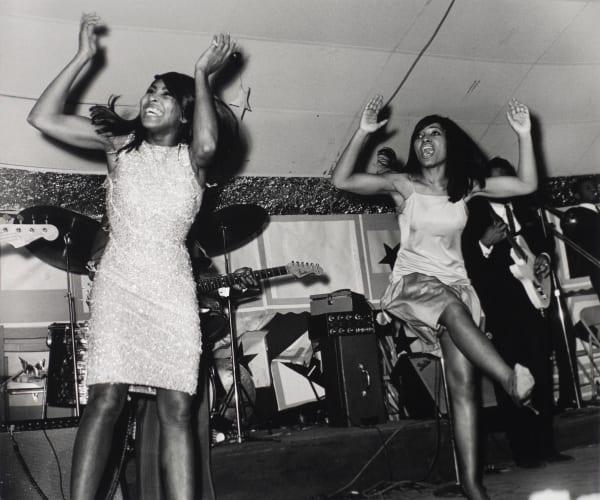Works
-
 Corner of Hernando and Beale St., at the time of Dr. Martin Luther King's last march. Memphis, 1968
Corner of Hernando and Beale St., at the time of Dr. Martin Luther King's last march. Memphis, 1968 -
 First press conference of the March Against Fear, announcing Martin Luther King,Jr., taking over after Meredith was shot, basement, United Methodist Church, with Floyd McKissick, Stokely Carmichael and others, Memphis, TN, 1966
First press conference of the March Against Fear, announcing Martin Luther King,Jr., taking over after Meredith was shot, basement, United Methodist Church, with Floyd McKissick, Stokely Carmichael and others, Memphis, TN, 1966 -
 Al Green, Mid-south Coliseum, August 1973
Al Green, Mid-south Coliseum, August 1973 -
 Big Maybelle with Rufus Thomas (to her left), 1950's
Big Maybelle with Rufus Thomas (to her left), 1950's -
 Ernest C. Withers in front of his delivery van, 1941 Ford Wagon, late 1940's
Ernest C. Withers in front of his delivery van, 1941 Ford Wagon, late 1940's -
 I Am a Man: Sanitation Workers Strike, Memphis, TN, 1968
I Am a Man: Sanitation Workers Strike, Memphis, TN, 1968 -
 James Brown, Mod-South Coliseum, Memphis, TN, ca 1975
James Brown, Mod-South Coliseum, Memphis, TN, ca 1975 -
 Ray Charles and Hank Crawford performing at City Auditorium, ca. 1961
Ray Charles and Hank Crawford performing at City Auditorium, ca. 1961 -
 Rhythm 'n' Blues Revue, on the midway at the Cottonmaker's Jubilee in the Beale Street Auditorium Park, early 1950's
Rhythm 'n' Blues Revue, on the midway at the Cottonmaker's Jubilee in the Beale Street Auditorium Park, early 1950's -
 Tina Turner, Ike and Tina Revue, Club Paradise, 1962
Tina Turner, Ike and Tina Revue, Club Paradise, 1962 -
 Waitresses and juke box, Plantation Inn, West Memphis, TN, 1950's
Waitresses and juke box, Plantation Inn, West Memphis, TN, 1950's
Biography
Ernest C. Withers was an African-American photojournalist. He is best known for capturing over 60 years of African American history in the segregated South, with iconic images of the Montgomery Bus Boycott, Emmett Till, Memphis sanitation strike, Negro league baseball, and musicians including those related to Memphis blues and Memphis soul.
Ernest C. Withers’ interest in photography began in his eighth-grade year at a Memphis school. More than seventy years later, he continued to maintain a studio on Beale Street – once the Memphis epicentre of the musical life of the nation. After graduation from high school in 1941, Withers joined the army. He attended the Army School of Photography and later operated a freelance business photographing white soldiers stationed in Saipan. Following his discharge, Withers purchased a photography studio in Memphis with help from the GI Bill*.
Throughout the 1950’s, Withers was, in his own words, ‘a news photographer’, ‘recording events that were taking place.’ Momentous events were occurring, and he recorded them for African American newspapers across the country. During the 1950’s and 1960’s, Withers travelled throughout the South with Dr. Martin Luther King Jr., James Meredith, Medgar Evers and other leaders of the Civil Rights movement. He provided images that made the dramatic stories of the era – a vivid Dr. King riding the first desegregated bus in Montgomery, murders of Civil Rights workers, voter registration drives, lynchings and the powerful Memphis Sanitation Workers Strike. The result is an encompassing and moving chronicle of the great American crusade of the second half of the Twentieth Century.
As he travelled across the South, Withers’ base was always his hometown of Memphis. His work provides an insider’s view of the Beale Street music scene at the point when Americans – black and white, began to recognize it as a musical Mecca. For more than a century the city had attracted rural African-American migrants who brought their music. Gospel, blues, rhythm and urban dance music rang out from churches and Beale St. clubs. On Saturday nights, Withers photographed audiences at the clubs for a dollar-fifty a shot.
Withers’ photographs proclaim the wealth of Memphis’ musical talent. They also showcase the Rock and Roll and blues that emerged from the city’s gospel as well as blues musical tradition. Given the relentless segregation, it was white musicians such as Elvis or Johnny Cash or Jerry Lee Lewis who brought the Memphis sound to the attention of the nation. Withers photographs clearly document the sound that was the product of the city’s black musical culture.
Exhibitions
Enquire












